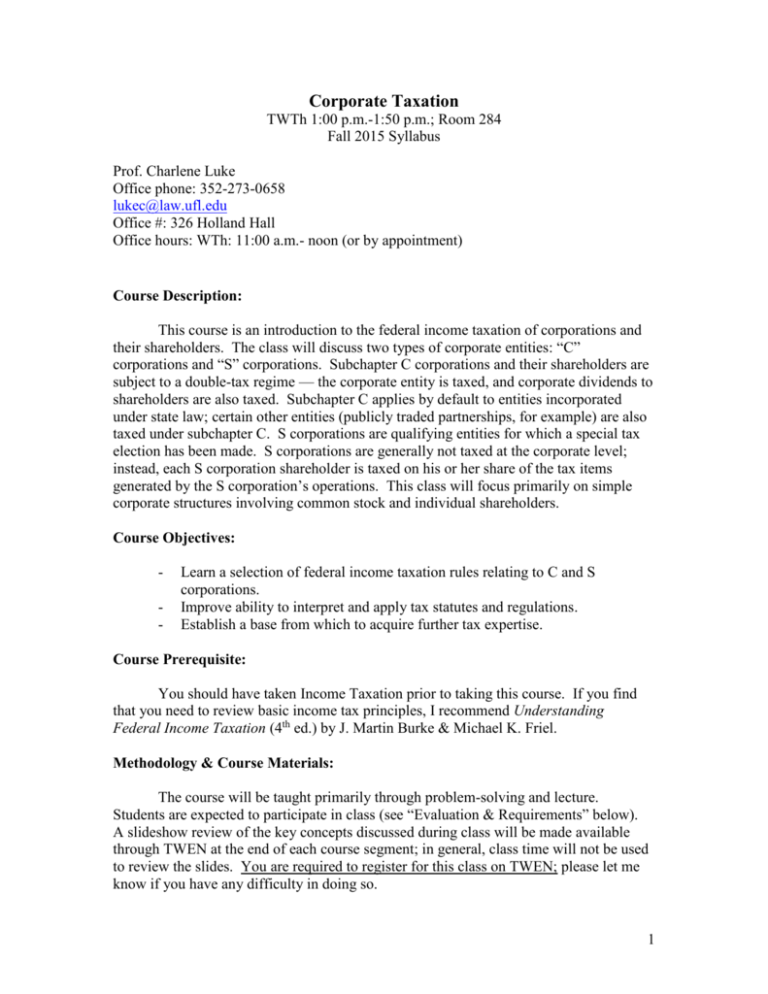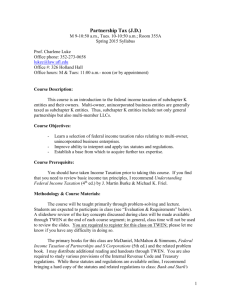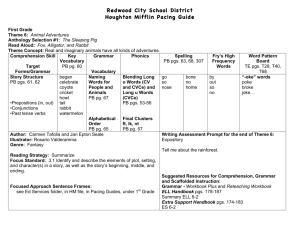Tax Policy Seminar
advertisement

Corporate Taxation TWTh 1:00 p.m.-1:50 p.m.; Room 284 Fall 2015 Syllabus Prof. Charlene Luke Office phone: 352-273-0658 lukec@law.ufl.edu Office #: 326 Holland Hall Office hours: WTh: 11:00 a.m.- noon (or by appointment) Course Description: This course is an introduction to the federal income taxation of corporations and their shareholders. The class will discuss two types of corporate entities: “C” corporations and “S” corporations. Subchapter C corporations and their shareholders are subject to a double-tax regime — the corporate entity is taxed, and corporate dividends to shareholders are also taxed. Subchapter C applies by default to entities incorporated under state law; certain other entities (publicly traded partnerships, for example) are also taxed under subchapter C. S corporations are qualifying entities for which a special tax election has been made. S corporations are generally not taxed at the corporate level; instead, each S corporation shareholder is taxed on his or her share of the tax items generated by the S corporation’s operations. This class will focus primarily on simple corporate structures involving common stock and individual shareholders. Course Objectives: - Learn a selection of federal income taxation rules relating to C and S corporations. Improve ability to interpret and apply tax statutes and regulations. Establish a base from which to acquire further tax expertise. Course Prerequisite: You should have taken Income Taxation prior to taking this course. If you find that you need to review basic income tax principles, I recommend Understanding Federal Income Taxation (4th ed.) by J. Martin Burke & Michael K. Friel. Methodology & Course Materials: The course will be taught primarily through problem-solving and lecture. Students are expected to participate in class (see “Evaluation & Requirements” below). A slideshow review of the key concepts discussed during class will be made available through TWEN at the end of each course segment; in general, class time will not be used to review the slides. You are required to register for this class on TWEN; please let me know if you have any difficulty in doing so. 1 The primary books for this class are McDaniel, McMahon & Simmons, Federal Income Taxation of Corporations (4th ed.) and the related problem book. The 2015 update for the casebook will be posed to TWEN; I may distribute additional reading and handouts through TWEN. You are also required to study various provisions of the Internal Revenue Code and Treasury regulations. While these statutes and regulations are available online, I recommend bringing a hard copy of the statutes and related regulations to class: Bank and Stark's Selected Sections: Corporate and Partnership Income Tax Code and Regulations. If you wish to consult a supplementary book on corporate tax, I recommend Understanding Corporate Taxation (2d ed.) by Leandra Lederman. Evaluation & Class Attendance Policy: Grade: 10 percent: Participation 90 percent: Final Exam Class Participation & Attendance: You are expected to attend class and to be prepared to respond to questions; attendance will be taken each day. Repeated lack of preparedness may be counted an unexcused absence. Repeated class disruption (e.g., excessive noise, texting, personal internet use, arriving late, leaving early) may be counted as an unexcused absence. You will be notified each time you accrue an unexcused absence on account of lack of preparedness and/or disruptive behavior. Absences taken for observance of religious holidays will be excused. If you are planning to miss class for a religious holiday, please let me know. If you are absent because of a special situation (sickness, family emergency, job interview, etc.), the absence may be excused at my discretion after you have provided adequate documentation of the situation and you have completed a make-up assignment. If you are dealing with a personal situation of high difficulty and prolonged duration, please seek assistance from me and/or the Student Affairs Office as soon as possible. Avenues for obtaining help are listed at http://www.law.ufl.edu/student-affairs/additionalinformation/have-a-problem-we-can-help. If you have more than five unexcused absences from regularly scheduled classes, your participation grade will be 0, and you may be barred from taking the final exam. 2 Final Exam: The final exam will be three hours and will be given during the time scheduled by the law school (currently scheduled for Weds., Dec. 9, 2015, at 1:00 p.m.). The exam will test your knowledge of the assigned problems and the related class discussion. The exam will be open book. You may not, however, consult materials via a computer or other electronic device. ExamSoft will be required if you wish to type your answers on computer. You may bring a basic calculator to the exam but it must not be associated with a device with wireless communication capabilities (e.g., the calculator may not be a smartphone or tablet app). The law school policy on delay in taking exams can be found at: http://www.law.ufl.edu/student-affairs/current-students/academic-policies#12. Grade Scale & Grading Policies: Grade A (Excellent) AB+ B (Good) BC+ C (Satisfactory) CD+ D (Poor) DE (Failure) Points 4.0 3.67 3.33 3.00 2.67 2.33 2.00 1.67 1.33 1.00 0.67 0.00 The law school grading policy is available at: http://www.law.ufl.edu/studentaffairs/current-students/academic-policies#9. Class Assignments: Reading and problem assignments are provided at the end of this syllabus. The schedule may be revised to reflect the pace of class discussion and/or any new legal developments. Two to three weeks will be spent discussing rules particular to S corporations; this may necessitate omitting some topics and/or problems (“Partial Liquidations” (in Part VI) and Stock Dividends (Part VII) would be the first to be omitted). If the syllabus is completed with time remaining in the semester, a section introducing more complex corporate structures will be added. Unless otherwise advised, you should assume that four problems will be covered per class session, and you should prepare accordingly. 3 Students will have the opportunity to complete optional assignments for feedback; in general, one optional assignment will be provided each week and will be tied to class discussion (thus, these will assignments will be provided ahead of time). Student grades will not be affected by these assignments, and the assignments may be turned in late; however, each student my turn in no more than 2 optional assignments per week during the semester. Other Policies, including Statement on Disability Accommodation: Additional law school and university policies may be found at (1) http://www.law.ufl.edu/student-affairs/current-students/academic-policies (academic policies) and (2) http://www.law.ufl.edu/student-affairs/additional-information/honorcode-and-committee (honor code). Students requesting classroom accommodation must first register with the Office of Disability Resources. The UF Office of Disability Resources will provide documentation to the student who must then provide this documentation to the Law School Office of Student Affairs when requesting accommodation. 4 Reading & Problem Assignments “CB” refers to the McDaniel, McMahon, & Simmons casebook; problems are from the related problem book. You are also responsible for reading the related Code provisions, Treasury regulations, and any updates to the CB. Please see “Class Assignments” above for more information regarding these assignments. I. Taxation of Corporate Income and Identifying Taxable Corporate Entities CB: 1-8 (until “The Alternative Minimum Tax”), 18-25 (beginning with “Identifying Taxable Corporate Entities” until “Foreign Business Entities”), 27-51 (beginning with “Regard and Disregard of the Corporate Entity”) Chapter 1 Problems: Complete all problems, except omit problem 2(b) of Section 2.A (pg. 2). II. Formation of the Corporation CB: 53-63 (until “Securities ‘Swap Funds’”), 69-72 (beginning with “‘Solely for Stock’—The Receipt of Other Property”), 77-120 Chapter 2 Problems: Section 1.A, problems 1-2 (pgs. 4-5); Section 1.C, problem 1 (pg. 6) (for each shareholder, substitute $200,000 cash for the $200,000 corporate promissory note; assume that corporate debt of $600,000 incurred at the same time as the other transactions is used to fund the cash payments); Section 2, all problems (pgs. 7-10); Section 3, problems 1 & 2(a) (pg. 11); Section 4, problem 1(a)-(b), problem 2(a), problem 3(b)-(c) (pgs. 13-14). III. The Capital Structure of the Corporation CB: 121-145 (until “Loans between Related Corporations”), 147-49 (beginning with “Transmutation of Debt to Equity” until “Convertible Obligations, Hybrid Securities, and Other Financial Instruments”), 151-161 (beginning with “Planning Considerations”) Problems: None assigned IV. Dividend Distributions CB: 177-194 (until “Effect of Stock Option Transactions”), 195-196 (beginning with “Federal Income Tax Costs” until “Parent and Subsidiary Earnings and Profits”), 197-203 (until “Distribution of Corporation’s Own Securities”), 204-218 (beginning with “Disguised Dividends” until “Below Market Rate of Interest Loans”), 219-230 5 Chapter 4 Problems: Section 2, problems 1, 2 & 4 (pgs. 19-21); Section 3, problems 1-5 (pgs. 21-23); Section 4, problems 2, 4 & 6 (pg. 24); omit Section 5 problems (but if time permits, handout with problems on dividends received deduction will be added) V. Stock Redemptions & “Bootstrap” Acquisitions Involving Individuals CB: 231-261 (until “Partial Liquidations”), 501-517 (until “Bootstrap Transactions Involving Corporations”) Chapter 5 Problems: Section 1, all problems (pg. 27); Section 2, problems 1(a)(d), 2-4, 6 (pgs. 27-30); Section 3, problems 1-4 (pgs. 30-32); Section 4, problem 1 (pg. 33) Chapter 11 Problems: Section 1, all problems (pgs. 74-75) VI. Partial Liquidations & Complete Liquidations CB: 261-272 (until “Redemptions Through the Use of Related Corporations”), 325-337 (until “Distribution of Installment Notes”), 339-341, skim 342-352 Chapter 5 Problems: Section 5, problems 1(a)-(c), 2 (pgs. 34-36) Chapter 7 Problems: Section 3, problems 1(a)-(c), 2, 4(a)(1), 4(b)-(c), 5-7 (pgs. 43-47) VII. Stock Dividends CB: 296-307 (until “Redemptions of Callable Preferred Stock”), skim 309-323 Chapter 6 Problems: Section1, problems 1-5, 7, 10-11 (pgs. 38-40) VIII. S Corporations CB: 355-409 (until “Qualified Subchapter S Subsidiaries”) Chapter 8 Problems: Section 2, all problems (pgs. 50-54), except skip problem 2, pg. 51, and skip problem 2, pg. 54; section 3, all problems (pgs. 54-57) 6





